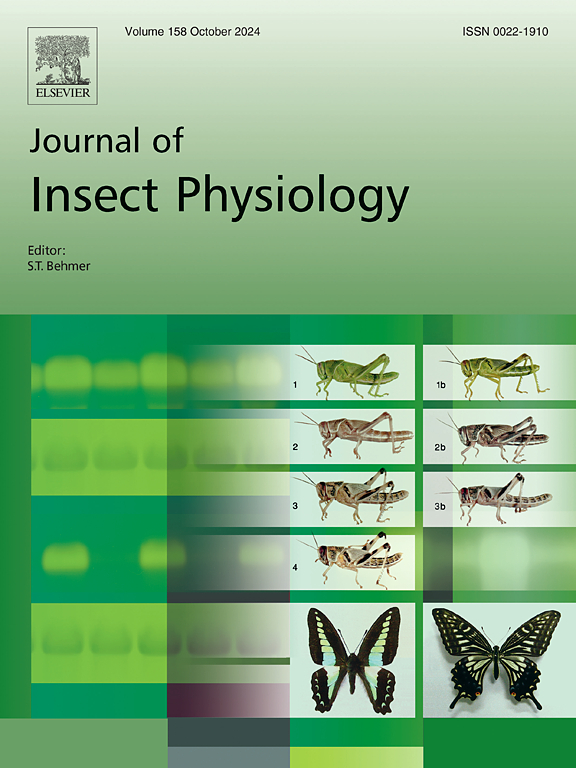Exploration of winter diapause stages of the emerald ash borer based on morphological and biochemical parameters
IF 2.3
2区 农林科学
Q1 ENTOMOLOGY
引用次数: 0
Abstract
Diapause enables the critical survival of certain insects under adverse conditions, and the concealment ability of insects makes characterizing diapause traits challenging. Here, we focused on the invasive emerald ash borer (EAB, Agrilus planipennis), a species with obligatory winter diapause, and combined morphological, physiological, and biochemical analyses to correlate overwintering diapause stages with two pupal chamber forms: J-shaped (JL) and I-shaped (IL) larvae. Fourth-instar larvae (L4, nondiapausing, still feeding) outside the chamber and pupae (postdiapausing) inside the chamber served as controls. The results revealed that 1) the JL and IL periods overlapped, lasting up to 7 and 5 months, respectively. Significant variations in physiological–biochemical parameters during JL prompted its subdivision into three substages: early (JL-E), middle (JL-M), and late (JL-L). 2) Compared with L4-stage insects, insects in the JL-E and/or JL-M stages presented significantly lower juvenile hormone (JH), trehalose, glucose, and inositol amounts, whereas the 20-hydroxyecdysone (20E) and glycerol amounts increased significantly. In the JL-L and IL stages, the amounts of JH, trehalose, glucose, and inositol no longer differed from those in L4. The IL-stage insects ultimately developed into pupae, with JH, glycerol, and inositol amounts comparable to those in the pupal stage. These findings demonstrate that the JL and IL stages in A. planipennis exhibit strong temporal correspondence with distinct diapause phases, as evidenced by their characteristic physiological signatures. This field-based multilevel study improves the understanding of the diapause biology of this invasive insect pest.

基于形态学和生化参数的绿灰螟虫冬季滞育阶段的探索。
滞育使某些昆虫在不利条件下临界生存,昆虫的隐蔽性使滞育特征的表征具有挑战性。本文以具有强制性冬季滞育的绿灰螟(Agrilus planipennis, EAB)为研究对象,结合形态学、生理和生化分析,将越冬滞育阶段与j形(JL)和i形(IL)两种蛹室形式联系起来。4龄幼虫(L4,未滞育,仍在取食)在室外,蛹(滞育后)在室内作为对照。结果表明:1)JL期和IL期重叠,分别长达7和5 个月;JL生理生化参数的显著变化促使其分为早期(JL- e)、中期(JL- m)和晚期(JL- l)三个亚阶段。2)与l4期相比,JL-E期和/或JL-M期昆虫的幼体激素(JH)、海藻糖、葡萄糖和肌醇含量显著降低,20-羟基蜕皮激素(20E)和甘油含量显著升高。在JL-L和IL期,JH、海藻糖、葡萄糖和肌醇的含量与L4期不再有差异。白介素期昆虫最终发育成蛹,其JH、甘油和肌醇含量与蛹期相当。这些研究结果表明,拟南芥的JL期和IL期与不同的滞育期具有较强的时间相关性,这是它们特有的生理特征所证明的。本研究提高了对该入侵害虫滞育生物学的认识。
本文章由计算机程序翻译,如有差异,请以英文原文为准。
求助全文
约1分钟内获得全文
求助全文
来源期刊

Journal of insect physiology
生物-昆虫学
CiteScore
4.50
自引率
4.50%
发文量
77
审稿时长
57 days
期刊介绍:
All aspects of insect physiology are published in this journal which will also accept papers on the physiology of other arthropods, if the referees consider the work to be of general interest. The coverage includes endocrinology (in relation to moulting, reproduction and metabolism), pheromones, neurobiology (cellular, integrative and developmental), physiological pharmacology, nutrition (food selection, digestion and absorption), homeostasis, excretion, reproduction and behaviour. Papers covering functional genomics and molecular approaches to physiological problems will also be included. Communications on structure and applied entomology can be published if the subject matter has an explicit bearing on the physiology of arthropods. Review articles and novel method papers are also welcomed.
 求助内容:
求助内容: 应助结果提醒方式:
应助结果提醒方式:


